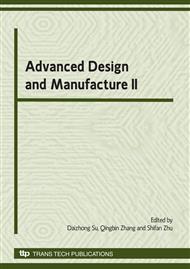p.13
p.17
p.21
p.25
p.29
p.33
p.37
p.41
p.45
Numerical Modeling and Design of an Inspection Device with Thermoelectric Coolers for the Coke Oven
Abstract:
In order to inspect on wall condition inside the coke oven, an inspection device has been developed to protect a camera inside and sustains high temperature long enough so that it can be permanently-installed on the pusher ram beam. The temperature of the coking chamber during operation is about 1200 °C while the maximum tolerable temperature of a camera is less than 40 °C. The device has to function as a good thermal insulator with cooling element for the camera at the pusher head and for signal cables along the beam. In this paper, the necessary conditions of the inspective device were found out by building a three-dimensional numerical model of the device to simulate the temperature distribution inside the device with CFD commercial software.
Info:
Periodical:
Pages:
29-32
Citation:
Online since:
October 2009
Authors:
Keywords:
Price:
Сopyright:
© 2010 Trans Tech Publications Ltd. All Rights Reserved
Share:
Citation:


